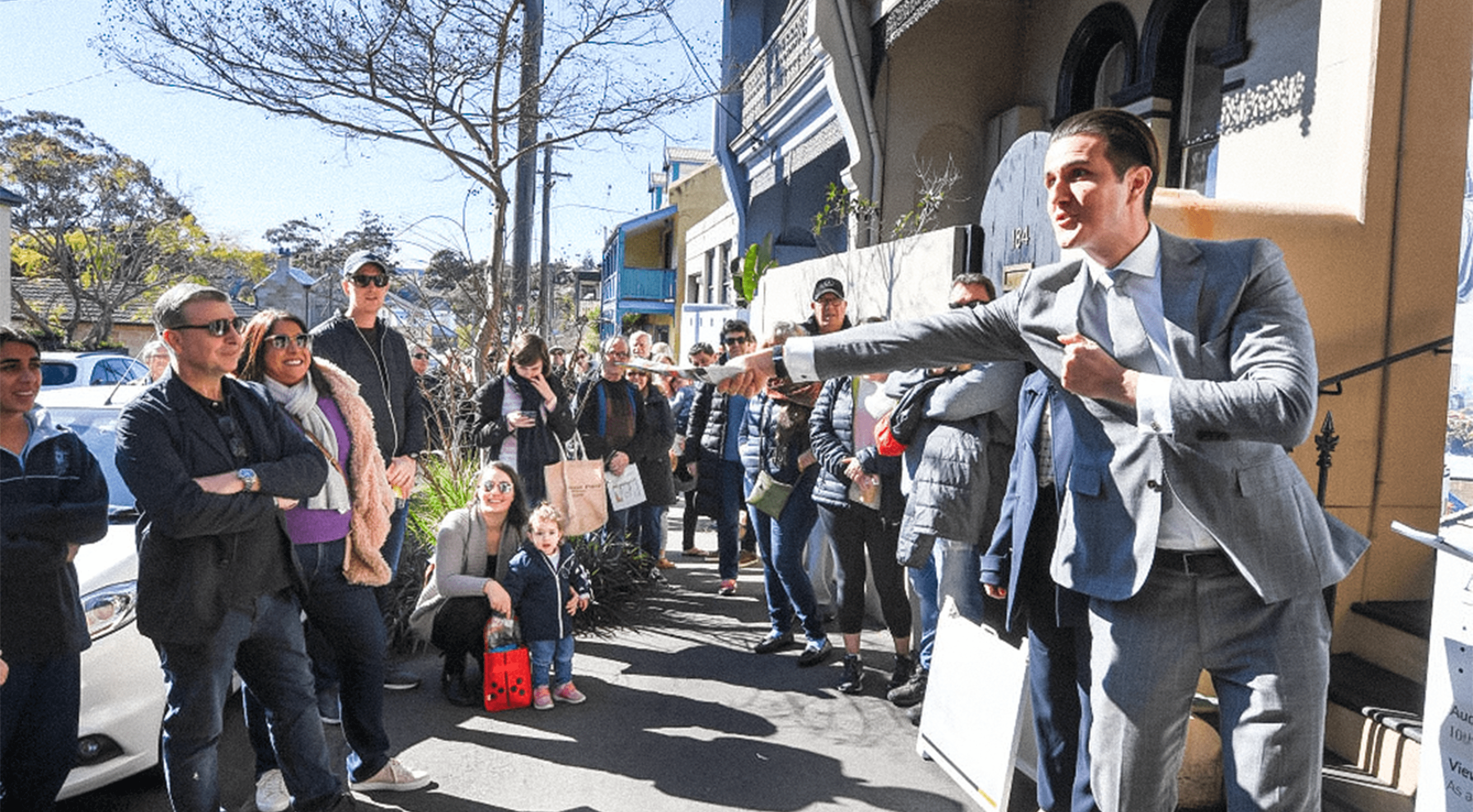Features > Property News & Insights > Investment News
Investor loans approach record levels amid tight rental market

Image from Domain/Peter Rae
KEY POINTS
- ABS data shows that new home loans rose 3.9% in July 2024 to $30.6 billion in seasonally adjusted terms.
- The growth is being driven by investors, with a 5.4% increase in July alone and a 35.4% or $3.06 billion value increase in just one year
- Investors are being attracted to residential property by good gross rental yields, fuelled by low vacancy rates and strong rental growth
Lured by a very tight rental market and good yields, investors are piling into Australian residential property.
New figures from the Australian Bureau of Statistics (ABS) show that lending to investors has soared to levels not seen since the Covid property boom when official interest rates were only 0.1%.
The details
The latest Lending Indicators data from the ABS shows that total national home loan commitments (excluding refinancing) rose 3.9% in July 2024 to $30.6 billion in seasonally adjusted terms.
The total value of new home loans approved in the month was $30.58 billion – up $1.2 billion on June’s numbers.
The Bureau of Statistics figures clearly show the growth in lending is being driven mainly by property investors.
Loans to investors grew by a whopping 5.4% or $605 million dollars in July alone and are up by an astonishing 35.4% or $3.06 billion in just one year.
“Helping to stoke investor demand is a very tight rental market and higher gross unit rental yields,” says Maree Kilroy, Senior Economist for Construction and Property Forecasting in Australia with Oxford Economics.
“Investor demand continues to outpace owner-occupiers”, she says, “rising 5.4% to an almost new monthly record of $11.708 billion, just shy of the January 2022 peak.”
In January 2022, Australia was in the midst of a Covid property boom, with thousands of investors lured into property by historically low interest rates.
At the time, the RBA was still maintaining an emergency pandemic cash rate of just 0.1%.
July’s investor lending figures are all the more astounding when you consider that the RBA cash rate is now 4.25% higher.
Yet even at a time of high interest rates, savvy investors are doing their sums and still can see the benefits of property investment.
Vacancy rates
According to SQM Research, the national rental vacancy rate in Australia in July 2024 was only 1.3%.
It actually got as low as 1% in March this year, in October 2023 and in October and November of 2022.
Those were the lowest vacancy rates in Australia since mid-2006.
Most analysts regard a vacancy rate of 3% as “balanced,” indicating that renters have a good choice of properties to choose from while landlords can still expect good rents.
Rental vacancies have been driven lower and lower over the last four years by an unusual confluence of events - abnormally high net overseas migration inflows after borders opened and the pandemic speeding up a longer-term trend towards smaller households.
Strong rent growth
The inevitable consequence of low vacancy rates has been strong rent growth as people compete for fewer available properties to let.
CoreLogic data shows median rents rocketed 39% higher between August 2020 and June 2024.
“For some context,” CoreLogic Australia’s Research Director Tim Lawless says, “the same period of time prior to the pandemic saw rents rise by just 5.4%.”
While Mr Lawless says rent growth has declined recently, “most cities are still recording an annual rental trend that is well above the pre-COVID average.”
You can clearly see below the effect this rent growth has had on gross rental yields, particularly for units in Australian capital cities.
Rates competition
The strong push from investors for loans is also seeing more competition among banks for a bigger slice of the investment lending pie.
“The spread between owner-occupier and investor mortgage rates has also progressively tightened with banks competing for market share,” Oxford Economics Maree Kilroy says.
A quick look at a loan comparison website shows that the average “spread” (or difference) between owner-occupier variable mortgage rates and investor rates has dropped to about 0.3%.
The final word
The rapid growth to almost record levels in new investment lending tells you that despite the doom and gloom we hear on the news about the economic climate in Australia, savvy investors can see a lucrative opportunity.
They can see there’s a severe housing shortage that isn’t going to ease any time soon.
They can also see the rental market is tight, that rents are high and unlikely to start coming down anytime soon.
They can see that if you buy the right property with a good rental yield and get all the associated tax deductions, that’s a seriously attractive investment.
Stay Up to Date
with the Latest Australian Property News, Insights & Education.




.png?width=292&height=292&name=Copy%20Link%20(1).png)
 SIGN UP FOR FREE NEWSLETTER
SIGN UP FOR FREE NEWSLETTER
%20(1).png)

.png)





.jpg?width=1920&height=1080&name=Warning%2c%20You%20Might%20Be%20Facing%20Higher%20Taxes%20Soon%20(1).jpg)





.png?width=1920&height=1080&name=Rate%20Drops%20Signal%20BIGGEST%20Property%20Boom%20in%20DECADES%20(1).png)

.jpg?width=1920&height=1080&name=Labor%20vs%20Liberal%20These%20Housing%20Policies%20Could%20Change%20the%20Property%20Market%20Forever%20(1).jpg)
.jpg?width=1920&height=1080&name=QLD%20Slashes%20Stamp%20Duty%20Big%20News%20for%20Investors%20%26%20Home%20Buyers%20(1).jpg)
.jpg?width=1920&height=1080&name=Trump%20Just%20Slapped%20Tariffs%20%E2%80%93%20Here%E2%80%99s%20What%20It%20Means%20for%20Australia%20(1).jpg)
.jpg?width=1920&height=1080&name=Federal%20Budget%202025%20More%20Debt%2c%20No%20Housing%20%E2%80%93%20Here%E2%80%99s%20What%20You%20Need%20to%20Know%20(1).jpg)
.jpg?width=1920&height=1080&name=Australias%20Housing%20Crisis%20is%20about%20to%20get%20MUCH%20Worse%20(New%20Data%20Warns).jpg)
%20(1).jpg?width=1920&height=1080&name=Australias%20RENTAL%20CRISIS%20Hits%20ROCK%20BOTTOM!%20(2025%20Update)%20(1).jpg)
%20(1).png?width=1920&height=1080&name=Is%20Adelaide%20Still%20a%20Good%20Property%20Investment%20(2025%20UPDATE)%20(1).png)
.jpg?width=1920&height=1080&name=RBA%20Shocks%20with%20Rate%20Cuts!%20What%E2%80%99s%20Next%20for%20Property%20Investors%20(1).jpg)
%20(1).jpg?width=1920&height=1080&name=I%20Predict%20The%20Feb%20Rate%20Cut%20(My%20Price%20Growth%20Prediction)%20(1).jpg)
.png?width=1920&height=1080&name=Why%20Property%20Prices%20Will%20Rise%20in%202025%20Market%20Predictions%20(1).png)
.jpg?width=1920&height=1080&name=Why%20Investors%20Are%20Choosing%20Apartments%20Over%20Houses%202%20(1).jpg)
.jpg?width=1920&height=1080&name=Why%20Rate%20Cuts%20Will%20Trigger%20A%20Property%20Boom%20(1).jpg)
.jpg?width=1920&height=1080&name=Retire%20On%202Million%20With%20One%20Property%20(Using%20SMSF).jpg)
.jpg?width=1920&height=1080&name=4%20Reasons%20Why%20You%20Should%20Invest%20in%20Melbourne%20Now%20(1).jpg)
%20(1).jpg?width=1920&height=1080&name=Old%20Property%20vs%20New%20Property%20(Facts%20and%20Figures%20Revealed)%20(1).jpg)
%20(1).jpg?width=1920&height=1080&name=Will%20The%20New%20QLD%20Govt%20Create%20a%20Property%20Boom%20or%20Bust%20(My%20Prediction)%20(1).jpg)
%20Scott%20Kuru%20(1).jpg?width=1920&height=1080&name=Inflation%20Hits%20Three-Year%20Low%20(Will%20RBA%20Cut%20Rates%20Soon)%20Scott%20Kuru%20(1).jpg)
.jpg?width=1920&height=1080&name=How%20to%20Buy%20Investment%20Property%20Through%20SMSF_%20The%20Ultimate%20Guide%20(1).jpg)
.jpg?width=1920&height=1080&name=Victoria%20Slashes%20Stamp%20Duty%20Melbourne%20Set%20to%20Boom%20Scott%20Kuru%20(1).jpg)
.png?width=1571&height=861&name=Are%20Foreign%20Buyers%20Really%20Driving%20Up%20Australian%20Property%20Prices%20(1).png)
.jpg?width=1920&height=1080&name=The%20Single%20Factor%20That%20Predicts%20Property%20Growth%20Regions%20(1).jpg)
%20Scott%20Kuru%20(1).jpg?width=1920&height=1080&name=My%20Prediction%20On%20Rates%20%26%20Negative%20Gearing%20(Market%20Crash)%20Scott%20Kuru%20(1).jpg)

-1.png?width=1920&height=1080&name=Major%20Banks%20Cut%20Rates%20Will%20RBA%20Follow%20Suit%20(Sept%20Rate%20Update)-1.png)
%20Scott%20Kuru-1.png?width=1920&height=1080&name=Rate%20Cut%20Coming%20What%20New%20Zealands%20Move%20Means%20for%20Australia%20(Sept%20Prediction)%20Scott%20Kuru-1.png)
%20(1).jpg?width=1920&height=1080&name=Buy%20when%20the%20interest%20rates%20are%20high!%20(Why%20you%20must%20buy%20now!)%20(1).jpg)
.jpg?width=1920&height=1080&name=Carms_Revised%20Taxes%20Due%20Aug%209%20YT%20Thumbnail02%20(1).jpg)
.jpg?width=1920&height=1080&name=Carms_Too%20Little%20Too%20Late%20Aug%207%20YT%20Thumbnail01%20(1).jpg)









.jpg?width=1920&height=1080&name=Carms_Rate%20Drop%20In%20July%20Jun%2010%20YT%20Thumbnail02%20(1).jpg)
.jpg?width=1920&height=1080&name=Carms_Own%20a%20Property%20V6%20Jun%205_YT%20Thumbnail%20(1).jpg)









.png?width=1920&height=1080&name=Artboard%201%20(3).png)






.jpg?width=1920&height=1080&name=YT%20thumbnail%20%20(1).jpg)

